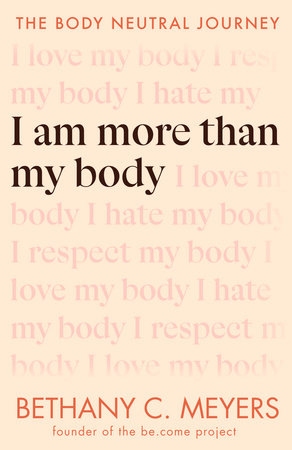The Journey Starts HereWhen I was young, I used to watch Nick at Nite religiously. I particularly loved
Bewitched and
I Dream of Jeannie, two 1960s sitcoms featuring glamorous, magical protagonists. I remember being convinced that I had supernatural powers too, I just hadn't learned my signature move yet. Samantha the witch would wiggle her nose and Jeannie would stack her arms and blink to access her genie gifts, so all I needed to do was find my own twitch. I would sit in my bedroom, make a wish, and then try a combination of tongue swirls, head nods, and finger taps-hoping to unlock some magical power. If you had walked in on me, I'm sure it would have been a funny sight. Of course, I never discovered my magic move. Like all of us, I've had to ask, work, and plan for the things I want in life, some of which have happened and some of which haven't. To me, the realization that the things we want don't happen magically-instead they take conscious effort and practice, but are nearly always worth it in the end-is reminiscent of the body neutral journey that we are about to embark upon together.
In short, body neutrality is the idea that each of us is more than our body, and our worth is not limited to our physical self. It is the practice of respecting our body despite the fact that we may feel differently about it on any given day-love, hate, and everything in between. When I was first learning about body neutrality, I remember having so many moments when I just wanted to get there already and proudly declare, "Here I am, meet
body neutral Bethany!" But that wasn't how my journey went. I would have days when I felt awful about my body, when my old eating disorder mindset would creep in and shame would take over. I also had days when I would pretend to be so completely in love with my body-and that felt empty as well, like I was masking the shame with a lie. And then I would have days when I would slide into neutrality, experiencing neither deep love nor deep shame, but rather a gentle respect for my physical self while prioritizing my emotional self. Sometimes that felt liberating and sometimes it felt unsatisfying. I'm here to tell you that both of those feelings-and anything in between-are okay!
Perhaps you may be hoping to read this book and find your quick fix into body acceptance. Maybe you are looking for a fuss-free solution to every problem you're facing. The truth is, that's not how it works, and you should be wary of anyone who tells you otherwise. This book doesn't make lofty promises, like fitness companies selling New Year deals or health food providers coming out with a fancy superfood. It is not the answer, the truth, the way, or the life. It is, I hope, a guide to a new set of skills which might support you. I'm not saying that the ideas housed between its covers don't have the power to have a profound impact on your life. They have certainly made dramatic shifts in mine. But I want expectations to stay realistic: this is not a book of life hacks, or a quick fix, or a one-stop-shop solution. It is not a cure-all. Practicing body neutrality in a world that is extremely biased is hard work. It's going to take effort, time, and a whole lot of grace.
What this book will provide you with is clarity, and a potential way forward. It will encourage you to deconstruct a lot of narratives in your mind, peel back the layers of the world you have been raised in, and interrogate the foundations of your relationship with your body and beyond. It will introduce a framework to help you manage and navigate some of your feelings, and offer lots of tangible guidance, journaling questions, and suggestions, to help support you on this journey. There is even a toolbox of tips from everyone interviewed in the book on page 205, which is a collection of their and my top advice. A lot of times, body neutrality involves sitting in a gray space-a place in the middle that can be uncomfortable. I promise I will be there to hold your hand and heart as you take these important steps.
As a fitness teacher, I developed a method to create an inclusive space for movement, founded in curiosity and a willingness to experiment without sticking to a rigid idea of what "success" looks like. That philosophy is something I have worked to bring with me into this book, and I hope it's something you will feel as you read it. When I present practical advice, I have aimed to do so in a way that feels nonjudgmental. I also present a range of experts' views for you to explore and connect with. I want you to think about how these ideas might apply to you. And also how do they not apply to you? What are you interested in getting curious about, and simultaneously what are you not? Where in this book do our ideas and beliefs align, and where do they differ? Individual thinking is celebrated here! I encourage you to do what is right for you, and not simply what has been suggested. This means you may not agree with everything in this book and that's okay. You are you, I am me, and together we have so much to learn from each other. What I will say is that you should give yourself permission to take this book at your own pace. Many of these issues run deep in all of us, and I want you to give yourself grace as you struggle with them.
In my classes I aim to give everyone practical tools they can use when I'm not there as well as when we are together. This book explains concepts and ideas, but ultimately it is encouraging a practice that you can take off the page, apply to your life, and keep getting better at. While there will inevitably be times when you slip off-track or feel like you've failed, the learnings never leave you. Once your mind is opened to the possibility that a new way of interacting with your body exists, there isn't a way to row backward from that. And the framework presented in this book will become easier to reconnect with over time, even if you're out of practice. Body neutrality is a journey and it doesn't have to go in a straight line, because the ultimate aim is to arm yourself with a new skill set.
Now, before we go any further, it's important for me to highlight how I have only ever experienced the world in a body that has been accepted and invited into nearly every imaginable space. As a white, slim person, the way my body intersects with society is privileged to an extent that I will never be able to fully comprehend. I have never experienced the realities of living in a marginalized body, nor one that the general population deems unworthy. While I have recognized elements of the queer identity in the process of my own self-discovery, in many contexts I get to choose whether I let the world judge me by my differences.
For some of you reading this book, the idea that you could be neutral about your body when the world you live in has so much bias and systemic prejudice may feel impossible. I don't know what that feels like, because I haven't walked in your shoes. That is one of the reasons I have welcomed so many other voices in the pages ahead. Voices of people who have had hugely diverse experiences in the world, due to their bodies, abilities, and identities. They include fat folks, persons with disabilities, queer folks, and people of color. My deepest hope is that this book will embrace a wide variety of bodies, and help open the door to body neutrality and respectful acceptance for everyone. The conversations in this book are not just my voice, nor only the voices of those I've interviewed; they are also your voice.
As we get ready to jump in, I am reminded of another silly memory from my childhood. On my first morning of kindergarten, my teacher told the class that we were going to play a game with a special shoebox. The box had been decorated and a hole had been cut in the top, and everyone had to stick their hand inside the box, feel the object within, and guess what it was. When the box came to me, I couldn't put my hand in. I was so scared of what I imagined was inside: something awful and gooey, or a mouse that was going to run up my arm, or something that would hurt me. All the other kids in the class put their hands in and made their guesses, but I couldn't do it. At the end of the game, the teacher opened the box and revealed that it was... a marshmallow. Soft, squidgy, sweet, and totally harmless.
***Leaping into anything new and unknown can feel terrifying, and you may find yourself freezing at something that others find easy to embrace. To this day I have a fear of sticking my hand into anything I cannot see. If something gets stuck in my kitchen sink, it’s almost impossible for me to reach my hand in to get it out. We can learn the marshmallow lesson and acknowledge that we don’t always need to be scared to jump in, but it still takes courage to try something new. And I recognize that is the case with body neutrality too. I think there is something that is a bit terrifying in letting go of your body in certain ways and not having it be the most important thing about you. It may always feel scary and it may always take some courage, but at the end of the day, it’s still going to be a fluffy little marshmallow waiting for you.
Chapter 1
What Is Body Neutrality?
How it beganI remember the first time I heard the term "body neutrality." I had been writing an article for a well-known health and wellness website, and they emailed me to ask if I could swap out the term "body positivity" for "body neutrality." You'll soon find out that these two practices are completely distinct, but back then it was the first time I had heard of body neutrality, and it stopped me in my tracks. Not in a good way-I was mad. No, I was fuming! I felt betrayed; I had worked so hard to gain a positive mindset about my body after coming out of eating disorders and body dysmorphia, and now what? I was supposed to feel neutral about it? I felt as though body positivity was being undermined, perhaps even criticized, by this other, unfamiliar label.
Being the type who hates being difficult yet loves challenging the rules (hello, Gemini), I wrote a carefully crafted email back to the editor. Slathered with southern charm and a touch of "bless your heart," my underlying message basically asked: why the hell would anyone want to be neutral about their body? Then I strapped on my metaphorical boxing gloves while I waited for a reply. But the response surprised me. Floored me actually. And to this day, the line that sticks out from that email is this:
It's more the idea that bodies are bodies, you are where you are, and that's okay. You love yourself as a person, not just as a body.
You love yourself as a person, not just as a body. My jaw dropped, tears sprang to my eyes, the boxing gloves melted off my hands. A spotlight shone above my head and I swear angels started singing "hallelujah." (Okay, maybe a slight exaggeration there.) It hit me at once:
I am more than my body.I began researching body neutrality, and every article, every definition, every personal account made me feel more and more at peace. I continued to learn more; I spoke about body neutrality with my community; and most importantly, I began to implement it in my recovery and my everyday life. I watched myself begin to find my neutral zone as I steered away from both extreme shame and a toxically positive mindset.
For me, finding body neutrality was accompanied by a sense of incredible relief-the likes of which I had never experienced before. To be honest with you, I am still on that journey, because "body neutral" isn't a destination you arrive at and then live happily ever after, but rather a place that every time you visit, you bring back a souvenir to help remind you of it. The more times you visit, the easier it is to get there.
But what
is body neutrality, I hear you ask from the back. Is it a replacement for body positivity, like that editor originally suggested? Or is it something completely separate? I get where the body positive/body neutral confusion comes from, because in a way they have the same aim-self-acceptance-and that is a beautiful thing. But to break it down simply: I like to say that body neutrality is the practice of steering away from self-hate without the pressure of having to love our body. Within neutrality there will be some days when we love our body and some days when we hate it, and many days in between. But no matter how we feel about what is staring back at us in the mirror, we work to respect our body.
Body neutrality is not saying that you shouldn't have any feelings about your body or that you should never think about your body, or that your body doesn't matter. But it is saying that your body does not dictate your worth. You are more than a body, and your value as a person extends far beyond your physical presence.
To some this might sound like common sense, but the truth for so many of us is that it requires a revolutionary shift in both outlook and behavior. Why is that? In truth, it's a variety of factors-many of which we'll discuss and explore throughout this book-but there is one central binary that is at the heart of it. When you look at how our society currently talks about bodies, you can clearly see two poles between which the pendulum swings: body shame and toxic positivity.
The first pole: body shameBody shame is heavily supported by diet culture, which is an insidious set of beliefs that worships exclusionary body and beauty standards-think flat stomach, long legs, perky butt, big lips, glossy hair, clear skin. It disempowers anyone and everyone who fails to meet these often unattainable goals. At its most extreme, diet culture is the social consensus that your appearance and body shape are more important than any other part of you-more important than your personality and character, achievements and contributions. And yes, even more important than your health. But it can also play out in smaller, more individual ways that also negatively impact your self-esteem and self-worth. For some,
it is that voice at the back of your head whispering that you are not good enough unless you have the "perfect" body.
What’s worse is that the beauty goalposts keep moving. During some eras, it was deemed desirable to havea curvaceous butt and hips, with a tiny little waist. A decade later, the butt was out and a string-bean, thin-hipped shape was in fashion. Then boobs were back. As I write this, today’s version of the “perfect body” isa seemingly impossible combination of individual bodyparts jigsawed together. Since we aren’t inflatable dolls, it’s pretty difficult to getan entirely new body shape every decade. And many of these fashionable body types are unrealistic for the vast majority outside of expensive cosmetic surgery. "I did Weight Watchers three times, the first at eleven yearsold, which had to be approved by a doctor," recalls AllyDuvall, a fat activist and body image program managerat Equip, a virtual care team for eating disorders. "I triedevery fad diet, restricted and punished myself in everyway possible. But I never achieved any of the results. I always blamed myself when my body weight didn’t change drastically, and this ended up pushing me further and further into brutal eating disorders. I starved myself literally, but I also starved myself of life."
While the details may change, in the Western world—or in societies influenced by Western media—thereis an emphasis on thinness, only possible for many through diets and frequent workouts. And that starts young. Today, girls as young as three show a preference for thinness; a sample of first through fourth graders showed that 41 percent wished they were thinner.
"Diet culture has dominated the vast majority of my life," says Alex Light, body confidence advocate and author of
You Are Not a Before Picture. "Probably from the moment I became aware of my body, I became aware of the fact that it didn’t look the way it should. It didn’t fit the ideal or the standard that was being reflected backat me from a really young age. I started dieting around the age of eleven and spent the next thirteen years flitting from one diet to another. I fully believed the diet culture myths that I would only be lovable, desirable, worthy, and successful if I was thin."
Copyright © 2023 by Bethany C. Meyers. All rights reserved. No part of this excerpt may be reproduced or reprinted without permission in writing from the publisher.







